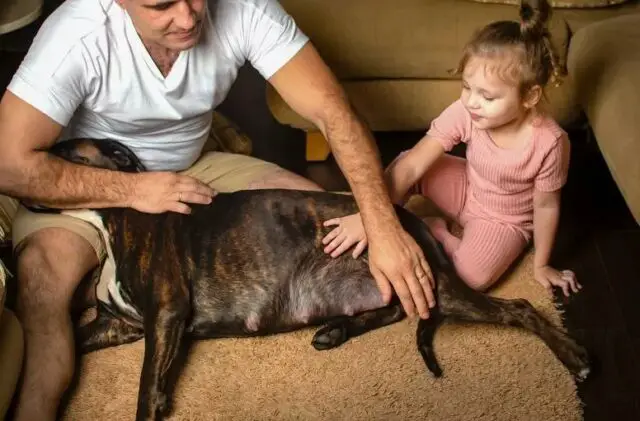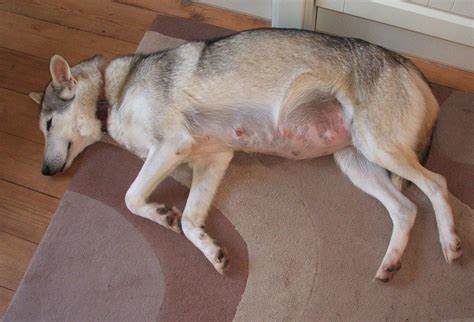Even though dogs frequently give birth without any assistance from you, pregnancy is a tough time for everyone, so you should still do your study and be ready.
It’s preferable to make sure you’ve done all necessary preparations to make the procedure as easy as possible for your cherished dog because no delivery comes without the possibility of difficulties for both the mother and her young pup.
To learn the best ways to assist a dog in labor and get ready for the arrival of the new puppies, we met with veterinarians.
The average dog pregnancy lasts 63 days and often lasts between 57 and 65 days.

Although it can be challenging to pinpoint a dog’s exact conception date because the sperm can survive inside the female for several days, and her eggs can remain fertile for up to 48 hours, meaning that the act of mating itself is not a precise indicator of gestation.
An expert says that many dogs will exhibit pregnancy symptoms, including appetite, weight gain, enlargement of the nipples, a swollen belly, and nesting behavior. However, these symptoms could also indicate a false pregnancy or other illnesses.
You can tell when a dog is going to give birth because of some common characteristics that she may show. The dog typically stops eating and experiences a rectal temperature below 100.5°F (38.1°C).
As the animal prepares for birth, nesting activity is another symptom. To prepare for bed, she often enters a quiet corner or area and begins scratching. Since this is the first stage of labor, when the delivery canal begins to enlarge, you may want to call your veterinarian if you see any of these symptoms in your pregnant dog.

You should keep a watchful eye on your pet once it starts to whelp. Your dog will appear restless and may pace, dig, shiver, pant, or even vomit during the initial stage of labor, which can last six to twelve hours. Within 12 hours, puppies should begin to emerge.
The delivery phase is the next. According to Dr. Carling Matejka, a veterinarian, and Solid Gold spokesperson, seeing green discharge during whelping is normal; however, if you see a discharge without a puppy soon after, it’s a sign that something is wrong and your dog needs assistance.
Puppies normally arrive every 45 to 60 minutes, so you should contact a veterinarian if you haven’t seen any after 30 to 60 minutes of frequent, severe contractions or if it’s been more than four hours since the last pup. Typically, the process takes less than 24 hours, and from the onset of the first contraction to the delivery of the last puppy, it typically takes three to twelve hours.
Most dogs don’t require assistance during labor, but when they do, you must be ready, according to Dr. Matejka.

Once your dog is getting close to the whelping phase, one useful technique to assist her is to keep an eye on her rectal temperature. It can help to determine when she will give birth, and once the temperature falls below 100F, she should give birth within 24 hours.
“When your dog first goes into labor, the best thing you can do is just quietly observe her,” Dr. Matejka said.
Your dog will begin to strain when she is ready to give birth to her first youngster, and each will be covered in a membrane that needs to be removed. This process takes between 10 and 30 minutes.
Dr. Carling advises using a clean towel to remove this coating from the puppy if your dog doesn’t lick and remove it on its own. Within 24 hours of delivery, you should have the puppies inspected by a veterinarian.

You must continue to feed her well after giving birth because she will need extra calories to nurse her puppies. You should also give her time to eat, rest, and most importantly, bond with her young. A whelping box, which you can either purchase already made or make yourself out of a sizable rigid cardboard box, is another way to assist your dog.
It should be warm and cozy; it should be placed in a peaceful, isolated area and kept at an average temperature of about 22°C; the box must be lined with clean, machine-washable, absorbent bedding (such as towels), big enough to stretch out and turn around in; and it must be puppy-proof.
Pets can experience issues during pregnancy and labor, known as whelping in dogs, just like people can. Pre-eclampsia (low calcium levels), gestational diabetes, mastitis (mammary gland infection), dystocia (difficulties giving birth), and retained placenta are among the most typical problems (placenta remains in the uterus).
According to Dr. Chris Broadhurst, a veterinarian at the Clay Humane Society, not only are dogs susceptible to all postnatal illnesses that affect people, but some particular dog breeds aren’t able to give birth naturally.

He clarified that English Bulldogs are the most notorious breed, noting that they cannot procreate naturally and require a C-section. “They have to be artificially inseminated, and then they have to have scheduled C-sections because the puppies’ heads are too big to fit out of the mother’s pelvis, so without medical intervention, English Bulldogs would really not exist these days.”
Dr. Broadhurst and the Clay Humane Society are against dog breeding, not because they detest puppies, but because too many dogs perish every year as a result of shelter overcrowding. Over 3.1 million dogs enter U.S. shelters each year, and at least 390,000 of them are put to death, according to statistics from the American Society for the Prevention of Cruelty to Animals (ASPCA).
Instead, he advises spaying and neutering dogs to protect them from testicular or breast cancer risks. “Female dogs that are spayed before their first heat cycle have effectively zero chance of breast cancer. But after one heat cycle, a single heat cycle average of one in four dogs will develop breast cancer, which can be benign or it can be malignant, and the malignant one is just as fatal for dogs as it is for humans,” according to the expert.
Male dogs who are not spayed or neutered are more likely to acquire testicular cancer. However, behavior problems are also prevalent in these animals, and removing the testosterone significantly reduces aggressive and territorial behavior.
Source: Newsweek









